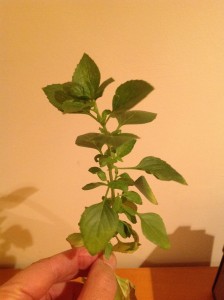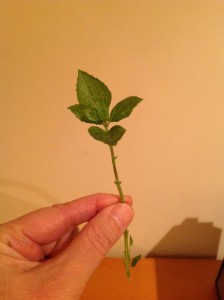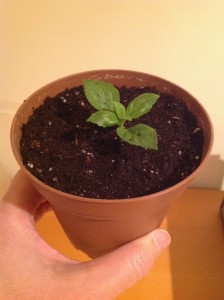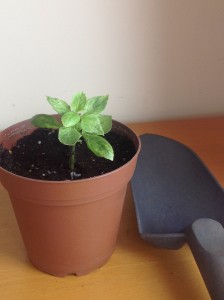Love the taste of basil? Ever get tired of it producing nothing but seeds by the end of the summer? Interested in an alternative?
If the answer is yes, yes and yes, then meet your new friend, columnar basil. Or, as a buddy of mine likes to call it, miracle basil.
Unlike the common basil, which is an annual, columnar basil is a perennial that does not produce seeds. Which means you can enjoy all that basil-y goodness right up until the first fall frost. Because although it is perennial, it is not hardy – it is perennial somewhere else: somewhere much warmer than Toronto, some lovely place where they do not have cold winters.
But wait a minute, you say, if it doesn’t produce seeds, then how do I obtain it? Unfortunately, you have to buy an initial starter plant from your local garden centre or nursery. Or perhaps you are lucky enough to be able to get a cutting from a friend.
Treat it as you would any other basil plant, meaning plant it in full sun, although it also seems to be happy in part shade. It grows to become a reasonably tall and narrow plant, which is where I assume the columnar name comes from. It is a bit slow to get going, but once it gets established, it does very well for the rest of the summer. The leaves are triangular, and look more like Thai basil than Italian basil. The taste is sweet, never bitter, and is perfect in a pesto.
Another miraculous thing about this plant is that it can be propagated from cuttings. In the fall, you can take a cutting from the plant, root it in a pot, and grow it indoors over the winter, then plant it out again the following spring. (You may need to take a second cutting in late winter or early spring, if the winter plant is getting leggy.) In this way, your initial purchased plant can live essentially forever! I’ve had mine for years. A miracle, indeed!
To propagate: cut off a branch of basil about 3″ long. Strip off all but the top few leaves. Stick it in a pot of dirt, and you are done! In a few weeks, you will notice new leaves growing. The last photo below was taken about a month after planting.






Oh…..J’espérais un article sur le columnar basil. Et le voici. Je me demande sous quel nom français je le trouverai à Montréal. Est-ce un basilic considéré comme ancestral?
Hi Christine, great timing! From what I can tell, this basil is called “columnar”, even in French. The scientific name may be Ocimum ×citriodorum, variety “Lesbos”. I found my original plant at Canadian Tire.